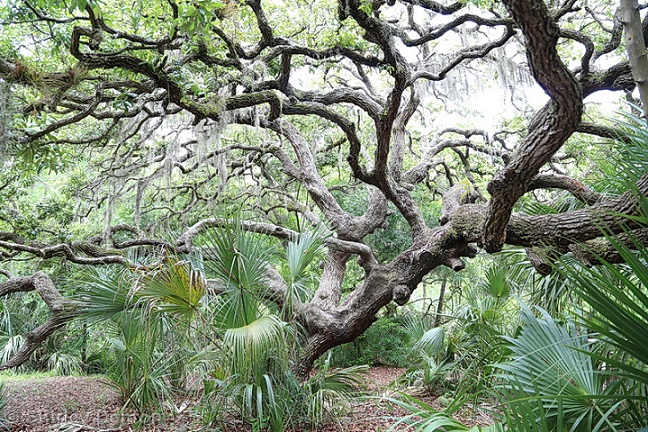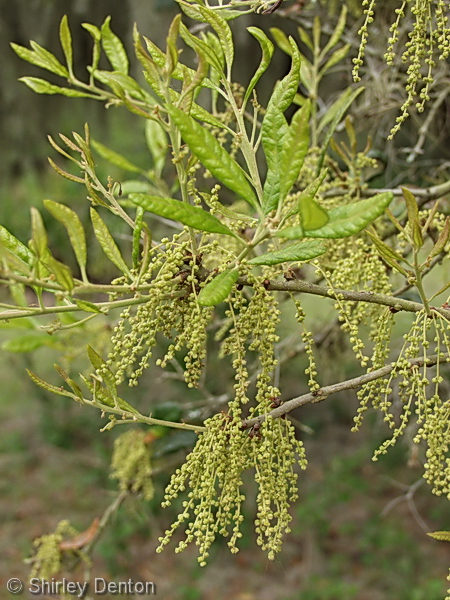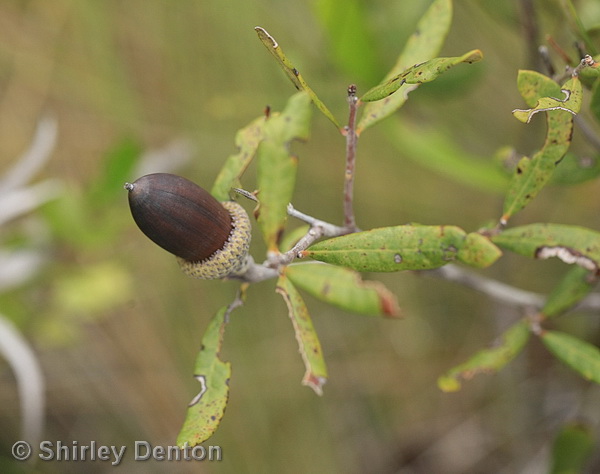Difference between revisions of "Quercus geminata"
| Line 18: | Line 18: | ||
}} | }} | ||
| − | Common name: | + | Common name: sand live oak |
==Taxonomic notes== | ==Taxonomic notes== | ||
Synonym: ''Quercus virginiana'' RAB | Synonym: ''Quercus virginiana'' RAB | ||
| Line 33: | Line 33: | ||
==Ecology== | ==Ecology== | ||
===Habitat=== <!--Natural communities, human disturbed habitats, topography, hydrology, soils, light, fire regime requirements for removal of competition, etc.--> | ===Habitat=== <!--Natural communities, human disturbed habitats, topography, hydrology, soils, light, fire regime requirements for removal of competition, etc.--> | ||
| − | In the Coastal Plain in Florida and Georgia, ''Q. geminata'' has occurred around | + | In the Coastal Plain in Florida and Georgia, ''Q. geminata'' has occurred around karst ponds, sand pine scrubs, sand pine-oak scrubs, mixed pine-hardwood forests, live oak woodlands, beach ridges, sand dunes, high river banks, coastal hammocks, an oak hammock adjacent to a marsh, longleaf pine sand ridges, scrub oak dunes,a pine-palmetto hammock in a salt marsh, and open wiregrass-longleaf flatwoods. It has been found in disturbed areas such as planted slash pine stands, shallow disturbed ravines, open pastures, sandy roadsides, and deep sandy soil of a once cultivated field. Soil types include sandy loam, sand and loamy sand. Associated species include ''Pinus palustris, Quercus laevis, Q. incana, Q. virginiana, Q. hemisphaerica, Vaccinium stamineum, V. arboreum, Serenoa repens, Cyrilla racemiflora, Prunus serotina, Prunus umbellata, Diospyros virginiana, Rhus copallina, Rubus cuneifolius, Licania michauxii'', and ''Warea sessilifolia.''<ref name="fsu">Florida State University Robert K. Godfrey Herbarium database. URL: http://herbarium.bio.fsu.edu. Last accessed: November 2015. Collectors: Loran C. Anderson, Wilson Baker, Tom Barnes, Celeste Baylor, Michael Brooks, M.R. Darst, J.P. Davis, D.L. Fichtner, Richard Franz, Angus Gholson, Robert K. Godfrey, D.W. Hall, Bruce Hansen, JoAnn Hansen, Walter S. Judd, Paul Kalaz, Robert Kral, O. Lakela, Sidney McDaniel, C.W. O’Brien, N.A. Reasoner, Ann M. Redmond, W.D. Reese, Cecil R. Slaughter, Cindi Stewart. States and Counties: Florida: Bay, Dixie, Duval, Calhoun, Citrus, Clay, Dixie, Escambia, Flagler, Franklin, Gulf, Hillsborough, Jackson, Leon, Liberty, Manatee, Marion, Okaloosa, Osceola, Pinellas, Polk, Putnam, St. Johns, St. Lucie, Sumter, Wakulla. Georgia: Baker, Brooks. Compiled by Tall Timbers Research Station and Land Conservancy.</ref> |
| + | |||
| + | ===Phenology=== <!--Timing off flowering, fruiting, seed dispersal, and environmental triggers. Cite PanFlora website if appropriate: http://www.gilnelson.com/PanFlora/ --> | ||
| + | Flowers in April, September, and October; and fruits May through November.<ref name="fsu"/> ''Q. geminata'' and ''Q. virginiana'' are known to hybridize despite genetic, morphological and ecological niche differentiation and are a good example of adaptive speciation.<ref name="cavender-bares">Cavender-Bares, J. and A. Pahlich (2009). "Molecular, Morphological, and Ecological Niche Differentiation of Sympatric Sister Oak Species, Quercus virginiana and Q. geminata (Fagaceae)." American Journal of Botany 96(9): 1690-1702</ref> | ||
| + | |||
| + | ===Seed dispersal=== | ||
| + | According to Kay Kirkman, a plant ecologist, this species disperses by gravity. <ref name="KK"> Kay Kirkman, unpublished data, 2015. </ref> | ||
| + | <!--===Seed bank and germination===--> | ||
| + | ===Fire ecology=== <!--Fire tolerance, fire dependence, adaptive fire responses--> | ||
| + | It can resprout after being top-killed by fire, 80% of the biomass is speculated to be underground.<ref name="floridata"/> Fire increases the density of grasshoppers found on ''Q. geminata.''<ref name="kerstyn">Kerstyn, A. and P. Stiling (1999). "The Effects of Burn Frequency on the Density of Some Grasshoppers and Leaf Miners in a Florida Sandhill Community." The Florida Entomologist 82(4): 499-505</ref> Fire does not affect the amount of ''Stilbosis quadricustatella'' miners on ''Q. geminata'' leaves.<ref name="mopper">[[Mopper, S., M. Beck, et al. (1995). "Local Adaptation and Agents of Selection in a Mobile Insect." Evolution 49(5): 810-815</ref> | ||
| + | <!--===Pollination===--> | ||
| + | |||
| + | ===Use by animals=== <!--Herbivory, granivory, insect hosting, etc.--> | ||
| + | Acorns provide food for wildlife such as quail, jays, wood duck, sapsuckers, and wild turkeys.<ref name="usanpn">[[https://www.usanpn.org/nn/Quercus_geminata]]Accessed: March 7, 2016</ref> This species is also a promary larval host plant for oak hairstreak (''Fixsenia favonius''), horace's duskywing (''Erynnis haratius''), red-banded hairstreak (''Calycopis cecrops'') and white M hairstreak (''Parrhasius m-album'') butterflies.<ref name="regional">[[http://regionalconservation.org/beta/nfyn/plantdetail.asp?tx=Quergemi]]Accessed: March 7, 2016</ref> | ||
| + | <!--===Diseases and parasites===--> | ||
| + | |||
| + | ==Conservation and management== | ||
| + | ==Cultivation and restoration== | ||
| + | ==Photo Gallery== | ||
| + | <gallery widths=180px> | ||
| + | File: Quer_gemi_SDenton-NatPhotography-flwr06.jpg | <center> Flowers and Fruit of ''Quercus'' ''geminata'' <p> Photos by Shirley Denton (Copyrighted, use by photographer’s permission only), [http://www.shirleydenton.com/welcome Nature Photography by Shirley Denton] </p> | ||
| + | File:Quer_gemi_SDenton-NatPhotography-fruit7178.JPG | ||
| + | </gallery> | ||
| + | ==References and notes== | ||
| + | Florida State University Robert K. Godfrey Herbarium database. URL: [http://herbarium.bio.fsu.edu http://herbarium.bio.fsu.edu]. Last accessed: November 2015. Collectors: Loran C. Anderson, Wilson Baker, Tom Barnes, Celeste Baylor, Michael Brooks, M.R. Darst, J.P. Davis, D.L. Fichtner, Richard Franz, Angus Gholson, Robert K. Godfrey, D.W. Hall, Bruce Hansen, JoAnn Hansen, Walter S. Judd, Paul Kalaz, Robert Kral, O. Lakela, Sidney McDaniel, C.W. O’Brien, N.A. Reasoner, Ann M. Redmond, W.D. Reese, Cecil R. Slaughter, Cindi Stewart. States and Counties: Florida: Bay, Dixie, Duval, Calhoun, Citrus, Clay, Dixie, Escambia, Flagler, Franklin, Gulf, Hillsborough, Jackson, Leon, Liberty, Manatee, Marion, Okaloosa, Osceola, Pinellas, Polk, Putnam, St. Johns, St. Lucie, Sumter, Wakulla. Georgia: Baker, Brooks. Compiled by Tall Timbers Research Station and Land Conservancy. | ||
Revision as of 14:08, 15 September 2016
| Quercus geminata | |
|---|---|

| |
| Photo by Shirley Denton (Copyrighted, use by photographer’s permission only), Nature Photography by Shirley Denton | |
| Scientific classification | |
| Kingdom: | Plantae |
| Division: | Magnoliophyta - Flowering plants |
| Class: | Magnoliopsida – Dicotyledons |
| Order: | Fagales |
| Family: | Fagaceae |
| Genus: | Quercus |
| Species: | Q. geminata |
| Binomial name | |
| Quercus geminata Small | |

| |
| Natural range of Quercus geminata from USDA NRCS Plants Database. | |
Common name: sand live oak
Contents
Taxonomic notes
Synonym: Quercus virginiana RAB
Quercus is formed from two Celtic words: quer (beautiful) cuez (tree). Geminata is Latin for twin, this refers to the acorns growing in pairs.[1]
Description
A description of Quercus geminata is provided in The Flora of North America.
Distribution
Q. geminata occurs in the lower Coastal Plain from southeastern Virginia to south-central Florida, along the Gulf to southern Mississippi.[1]
Ecology
Habitat
In the Coastal Plain in Florida and Georgia, Q. geminata has occurred around karst ponds, sand pine scrubs, sand pine-oak scrubs, mixed pine-hardwood forests, live oak woodlands, beach ridges, sand dunes, high river banks, coastal hammocks, an oak hammock adjacent to a marsh, longleaf pine sand ridges, scrub oak dunes,a pine-palmetto hammock in a salt marsh, and open wiregrass-longleaf flatwoods. It has been found in disturbed areas such as planted slash pine stands, shallow disturbed ravines, open pastures, sandy roadsides, and deep sandy soil of a once cultivated field. Soil types include sandy loam, sand and loamy sand. Associated species include Pinus palustris, Quercus laevis, Q. incana, Q. virginiana, Q. hemisphaerica, Vaccinium stamineum, V. arboreum, Serenoa repens, Cyrilla racemiflora, Prunus serotina, Prunus umbellata, Diospyros virginiana, Rhus copallina, Rubus cuneifolius, Licania michauxii, and Warea sessilifolia.[2]
Phenology
Flowers in April, September, and October; and fruits May through November.[2] Q. geminata and Q. virginiana are known to hybridize despite genetic, morphological and ecological niche differentiation and are a good example of adaptive speciation.[3]
Seed dispersal
According to Kay Kirkman, a plant ecologist, this species disperses by gravity. [4]
Fire ecology
It can resprout after being top-killed by fire, 80% of the biomass is speculated to be underground.[1] Fire increases the density of grasshoppers found on Q. geminata.[5] Fire does not affect the amount of Stilbosis quadricustatella miners on Q. geminata leaves.[6]
Use by animals
Acorns provide food for wildlife such as quail, jays, wood duck, sapsuckers, and wild turkeys.[7] This species is also a promary larval host plant for oak hairstreak (Fixsenia favonius), horace's duskywing (Erynnis haratius), red-banded hairstreak (Calycopis cecrops) and white M hairstreak (Parrhasius m-album) butterflies.[8]
Conservation and management
Cultivation and restoration
Photo Gallery
Flowers and Fruit of Quercus geminata Photos by Shirley Denton (Copyrighted, use by photographer’s permission only), Nature Photography by Shirley Denton
References and notes
Florida State University Robert K. Godfrey Herbarium database. URL: http://herbarium.bio.fsu.edu. Last accessed: November 2015. Collectors: Loran C. Anderson, Wilson Baker, Tom Barnes, Celeste Baylor, Michael Brooks, M.R. Darst, J.P. Davis, D.L. Fichtner, Richard Franz, Angus Gholson, Robert K. Godfrey, D.W. Hall, Bruce Hansen, JoAnn Hansen, Walter S. Judd, Paul Kalaz, Robert Kral, O. Lakela, Sidney McDaniel, C.W. O’Brien, N.A. Reasoner, Ann M. Redmond, W.D. Reese, Cecil R. Slaughter, Cindi Stewart. States and Counties: Florida: Bay, Dixie, Duval, Calhoun, Citrus, Clay, Dixie, Escambia, Flagler, Franklin, Gulf, Hillsborough, Jackson, Leon, Liberty, Manatee, Marion, Okaloosa, Osceola, Pinellas, Polk, Putnam, St. Johns, St. Lucie, Sumter, Wakulla. Georgia: Baker, Brooks. Compiled by Tall Timbers Research Station and Land Conservancy.
- ↑ 1.0 1.1 1.2 [[1]]Floridata. Accessed: March 7, 2016
- ↑ 2.0 2.1 Florida State University Robert K. Godfrey Herbarium database. URL: http://herbarium.bio.fsu.edu. Last accessed: November 2015. Collectors: Loran C. Anderson, Wilson Baker, Tom Barnes, Celeste Baylor, Michael Brooks, M.R. Darst, J.P. Davis, D.L. Fichtner, Richard Franz, Angus Gholson, Robert K. Godfrey, D.W. Hall, Bruce Hansen, JoAnn Hansen, Walter S. Judd, Paul Kalaz, Robert Kral, O. Lakela, Sidney McDaniel, C.W. O’Brien, N.A. Reasoner, Ann M. Redmond, W.D. Reese, Cecil R. Slaughter, Cindi Stewart. States and Counties: Florida: Bay, Dixie, Duval, Calhoun, Citrus, Clay, Dixie, Escambia, Flagler, Franklin, Gulf, Hillsborough, Jackson, Leon, Liberty, Manatee, Marion, Okaloosa, Osceola, Pinellas, Polk, Putnam, St. Johns, St. Lucie, Sumter, Wakulla. Georgia: Baker, Brooks. Compiled by Tall Timbers Research Station and Land Conservancy.
- ↑ Cavender-Bares, J. and A. Pahlich (2009). "Molecular, Morphological, and Ecological Niche Differentiation of Sympatric Sister Oak Species, Quercus virginiana and Q. geminata (Fagaceae)." American Journal of Botany 96(9): 1690-1702
- ↑ Kay Kirkman, unpublished data, 2015.
- ↑ Kerstyn, A. and P. Stiling (1999). "The Effects of Burn Frequency on the Density of Some Grasshoppers and Leaf Miners in a Florida Sandhill Community." The Florida Entomologist 82(4): 499-505
- ↑ [[Mopper, S., M. Beck, et al. (1995). "Local Adaptation and Agents of Selection in a Mobile Insect." Evolution 49(5): 810-815
- ↑ [[2]]Accessed: March 7, 2016
- ↑ [[3]]Accessed: March 7, 2016

